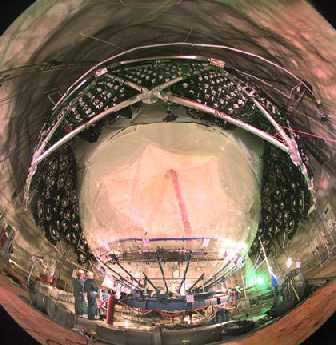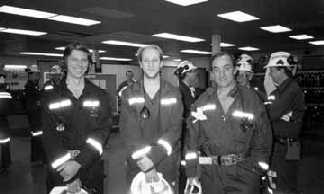![]()
SNO: Looking at the Sun from Two Kilometers Underground
By Monica Friedlander (msfriedlander@lbl.gov)
December 5, 1997

Where's the best place to study one of the enduring mysteries about the sun? Surprisingly, in this case it's two kilometers underground. Deep within the earth, scientists are assembling this massive geodesic dome which is covered with an array of 10,000 sensors. One aim is to detect and unravel the mystery of the missing solar neutrinos.
Berkeley Lab photographer Roy Kaltschmidt is no stranger to outlandish photo shoots. Past assignments had him shooting out of an open doorway from a little plane flying sideways and from the top of the Golden Gate Bridge. But his recent trip to the bowels of the earth to document the Sudbury Neutrino Experiment -- SNO for short -- was unlike anything he had experienced before."You have the feeling of witnessing something futuristic, not of this earth," Kaltschmidt said. "At least on top of the Golden Gate you have a bearing of where you are. Here you feel like you lose connection to the earth."
Built two kilometers under solid rock in a cavity the size of a 10 story building, the SNO experiment involves an international collaboration of 70 scientists from the U.S. (including Berkeley Lab), Canada, and Great Britain. Its aim: to unravel the mysteries of what may be the most common particle in the universe -- the neutrino.
For about half a century, this tiny, elusive particle and messenger from the sun has puzzled scientists. Because of its weak interaction with atomic nuclei, the neutrino travels freely through any material object and is very difficult to observe. Deep underground, the elaborate experiment is shielded from interference with ubiquitous cosmic rays, allowing scientists to observe tiny bursts of light that take place when neutrinos collide with other particles. Among other things, scientists hope to determine why experiments over the years have noticed an apparent deficit of solar neutrinos, or whether or not the particle has even the tiniest mass.
Scientists take a break from work. Left to right are Berkeley Lab project leader Kevin Lesko and Oxford's Martin Moorhead and George Doucas
"This experiment offers us the opportunity to look into the sun and understand how it works," said nuclear scientist Kevin Lesko, project leader for the Berkeley part of the experiment. "We can learn about the nature of the neutrino, and if it has a little bit of mass, perhaps even answer some questions about dark matter and missing mass in the universe."
The ambitious project, to be finished early next year, is made possible by what is really a state-of-the-art underground laboratory built inside a nickel mine in Sudbury, Ontario -- about an hour's flight from Toronto. The core of the experiment consists of a large acrylic vessel, 12 meters across, soon to be filled with a thousand tons of pure heavy water -- $300 million's worth -- on loan from the Canadian government.
The membrane-like vessel consists of 120 clear plastic sheets just five centimeters thick and bonded tightly together; it is enclosed in a stainless steel geodesic sphere, 18 meters across, covered with an array of 10,000 photomultiplier tubes, which was constructed at Berkeley Lab. Peter Purgalis, now retired from the Lab, designed the geodesic sphere and Gary Koehler of the Engineering Division designed the panels and tube housings. The sphere was assembled in Petaluma and shipped to Canada four years ago.
To oversee his part of the experiment, Lesko spends up to 100 days each year working inside the mine. "When you have a laboratory like Berkeley and you want to built something, it's relatively easy," he said. "You've got the infrastructure, you've got the engineers, the people you need. We started in the middle of Canada and had to build the infrastructure from barren ground."
To put together the observatory, pieces of equipment had to be lowered into the mine shaft through an elevator the size of a closet, then carted two kilometers along a tunnel to the cavity of the observatory and cleaned or decontaminated along the way to prevent any impurities from interfering with the experiment.
This is largely what Roy Kaltschmidt had to go through himself to make it to the observatory for his photo shoot on a snowy early morning last month. Dressed in miners' overalls and a hard hat, he caught the 6:30 a.m. elevator that took the miners down for their regular shift. "We were packed like sardines in this rectangular cage, shoulder to shoulder, row to row, unable to move," Kaltschmidt recalled. "The elevator is suspended on cables, bouncing around, with the only light on the helmet."
Once out of the cage, Kaltschmidt, Lesko and a few other Berkeley colleagues walked through the two kilometer horizontal tunnel to a decontamination area, where they were stripped naked, showered and given clean room clothes. After going through an air shower, they continued to a small elevator that took them to the cavity of the observatory.
"The place is more sterile than a hospital operating room," Kaltschmidt said. "It adds to this incredible feeling."
Concurs Lesko with a chuckle: "We thought we ought to get someone from Industrial Light and Magic to shoot this place. You could do a great science fiction movie."
Once inside, small lifts raised Kaltschmidt to allow him to take pictures from under the black top of the geodesic sphere. The vessel is surrounded by low lighting to keep the photo sensors safe. Lesko helped Kaltschmidt take pictures by swinging a 60 Watt lamp around during the long exposures. "You feel like you're in the middle of the Milky Way with stars blinking around you," Kaltschmidt said.
Unfortunately, the Berkeley team only had three hours to spend at the observatory, since everyone had to be out in time for some mining blasts. Both Kaltschmidt and the scientists wish they could have set their own schedule, a luxury they do not have. Indeed, the experiments provides scientists with their fair share of frustrations.
"When I lived in Seattle, I used to have some friends who lived on the island, and they objected to how the ferry schedule ran their whole lives," commented Lesko. "That sort of thing is true here, too. To get down there, you have to meet the schedule of the mine. The cage goes down at 6:30, so you have to get up at 5. Science people are used to working 12 to 14 hour days. There you can work only six hours, like the miners. You can't get as much done as you'd like."
But for all these inconveniences, Lesko said the experience has helped him appreciate even more the wonders of science and the support that a lab like Berkeley can provide. "Every time we ran into a problem, I found the solution was already taken care of," he said. "That's what a national lab can really do well. About 95 percent of the problems were solved before we even got there."
Lesko is scheduled to return to Sudbury in early December to oversee part of the final construction phase of the geodesic sphere. About 2,000 light sensors must still be added, with the construction expected to be finished by the end of January. That's just in time for the February inaugural ceremony, for which Vice President Gore and the Canadian and British prime ministers are expected to show up.
"That will be quite a party," Lesko said.
